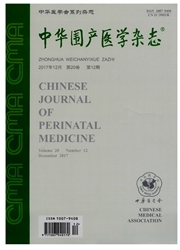

 中文摘要:
中文摘要:
目的研究早产新生大鼠高氧肺损伤肺组织中凋亡信号调节激酶1( apoptosis signalregulating kinase 1, ASK1 ) 及硫氧还蛋白(thioredoxin,Trx)和硫氧还蛋白还原酶(thioredoxin reduetase,TrxR)的表达变化及意义,探讨高氧肺损伤的发病机制和防治措施。方法早产新生SD大鼠128只,生后1d随机分为空气组和高氧组,每组64只。两组于生后1、4、7、10、14d各时间点处死8只大鼠取肺组织,采用HE染色观察肺组织病理学变化;采用逆转录-聚合酶链反应技术测定Trx和TrxRmRNA表达;免疫组织化学方法检测肺组织ASK1蛋白的表达和分布,Western印迹法检测ASK1蛋白表达水平变化。两组间比较采用t检验。结果(1)肺组织病理学:与对照组比较,高氧组肺组织出现明显肺泡炎性改变和肺发育滞后。(2)肺组织ASK1广泛分布于肺泡上皮细胞和血管内皮细胞胞浆中;高氧暴露1、4d肺组织ASK1蛋白表达分别为0.4382±0.0227和0.5270±0.0432,高于空气组(0.3458±0.0263和0.3760±0.0058)(P〈0.01),7d时下降为0.4343±0.0254,但仍高于空气组(0.3473±0.0220)(P〈0.01)。(3)高氧组Trx和TrxRmRNA表达强度均高于空气组,且二者分别于10d(0.6860±0.0811)和7d(2.0351±0.1600)时达高峰(P%0.05)。(4)Western印迹法检测ASK1蛋白水平变化与免疫组织化学法的结果一致。结论ASK1可能参与高氧肺损伤的发生发展,而Trx系统可能在其中发挥重要保护作用。
 英文摘要:
英文摘要:
Objective To investigate the changes and potential roles of the expression of apoptosis signal-regulating kinase I(ASK1), thioredoxin (Trx) and thioredoxin reductase (TrxR) in the pathogenesis of lung injury of premature newborn rats exposed to hyperoxia. Methods In the first day after delivery, preterm SD rats were randomly divided into air group and hyperoxia group with 64 rats in each. The rats were respectively sacrificed at 1,4, 7, 10 and 14 days after air or hyperoxia exposure. Sections of lungs were stained with HE to observe the histologie changes. Trx and TrxR mRNA were detected by reverse transcription polymerase chain reaction (RT PCR). Immunohistoehemistry was used to detect the expression and distribution of ASK1. Western blot was used to detect the expression of ASK1 protein. Results Rats in hyperoxia group showed typical lung injury, which was characterized by alveolitis and delayed of lung development. Immunohistochemistry detected that ASK1 expressed generally in the cytoplasm of both alveolar epithelial cells and vascular endothelial ceils; ASK1 protein expression in hyperoxia group at lth and 4th day were 0. 4382 ±0. 0227 and 0. 5270± 0. 0432, higher than in the air group(0. 3458 ± 0. 0263 and 0. 3760 ± 0. 0058) (P〈0.01), and it was until 7th day that the expression became weaker(0.4343±0.0254), but still higher compared with the air group(0. 3473±0. 0220)(P〈0.01). Compared with the air group, Trx and TrxR mRNA of the hyperoxia group increased significantly and peaked at 10th day(0. 6860± 0.0811) and 7th day(2.0351±0.1600), respectively(P〈0.05). ASK1 protein expressions resulting from Western blot had the same trends with the results from immunohistochemistry. Conclusions ASK1 participates in the pathogenesis of hyperoxia-indueed lung injury, and Trx and TrxR could be the important protective factors in this process.
 同期刊论文项目
同期刊论文项目
 同项目期刊论文
同项目期刊论文
 期刊信息
期刊信息
